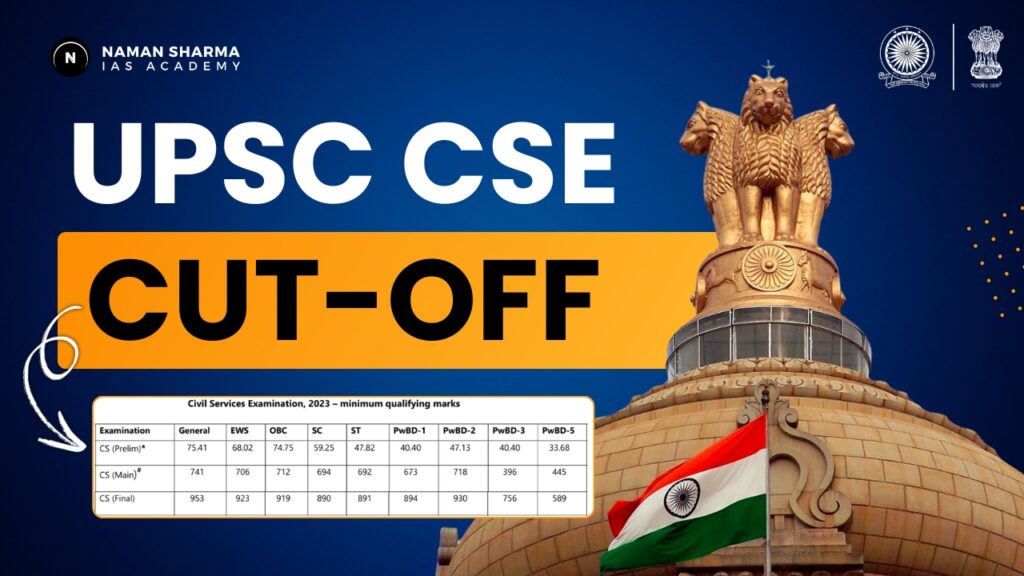Understanding the UPSC Cut-Off: Your Gateway to India’s Elite Civil Services
The UPSC Civil Services Examination (CSE) is a rigorous 3 STAGE journey where the cut-off marks act as the ultimate gatekeeper..
The UPSC Civil Services Examination (CSE) is a rigorous 3 STAGE journey where the cut-off marks act as the ultimate gatekeeper, shaping the destiny of lakhs of aspirants competing for coveted roles like the Indian Administrative Service (IAS), Indian Police Service (IPS), Indian Foreign Service (IFS), Indian Revenue Service (IRS), and other Group-A services, Group-B services. While the CSE is designed to test candidates’ knowledge, analytical prowess, and personality, the cut-off remains the critical benchmark that separates success from stagnation at every stage.

Prelims – The First Hurdle
The Preliminary Examination is a qualifying round where candidates must cross the sectional and overall cut-off to advance to the Mains. Here, the cut-off serves as a filtering mechanism. Prelims Phase is divided into two stages:
- GS 1 (GENERAL STUDIES PAPER 1) – clearing the cut off
- CSAT (PAPER 2)- qualifying 33% threshold
Remember: Clearing Prelims is non-negotiable, but it’s only the first step.
Marks Distribution
- GS1 – 100 questions ( 2 marks each ) Total = 200 marks
- CSAT – 80 questions ( 2.5 marks each ) Total = 200 marks
- Negative marks: Preliminary Examination, 1/3rd of the total marks allocated to that question is deducted.
UPSC PRELIMS CUT OFF FOR THE LAST 5 YEARS
| Category | 2024 | 2023 | 2022 | 2021 | 2020 |
| General | 87.98 | 75.41 | 88.22 | 87.54 | 92.51 |
| OBC | 87.28 | 74.75 | 87.54 | 89.12 | 89.12 |
| ST | 74.23 | 47.82 | 47.82 | 70.71 | 68.71 |
| SC | 79.03 | 59.25 | 74.08 | 75.41 | 74.84 |
| PWD 1 | 69.42 | 40.40 | 49.84 | 68.02 | 70.06 |
| PWD 2 | 65.30 | 47.13 | 58.59 | 67.33 | 63.94 |
| PWD 3 | 40.56 | 40.40 | 40.40 | 43.09 | 40.82 |
| PWD 5 | 40.56 | 33.68 | 41.76 | 45.80 | 42.86 |
| EWS | 85.92 | 68.02 | 82.83 | 80.14 | 77.55 |
Mains – Where The Real Battle Begins
The UPSC Mains Exam Pattern consists of 9 papers, out of which 7 papers are counted for the final merit ranking, and two are qualifying in nature.
NOTE
- Paper-A (Indian Languages) and Paper-B (English) are qualifying in nature, and candidates need to secure a minimum of 25% marks in each to qualify for the evaluation of other papers.
- This total cut-off is subject to the mandatory 10% marks that candidates have to score in each of the seven papers, i.e. Essay, GS-I, GS-II, GS-III, GS-IV, Optional-I and Optional-II.
- The optional subject papers (Paper-VI and Paper-VII) are based on the subject chosen by the candidate from the list of UPSC Optional Subjects.
- TOTAL MARKS = 1750 MARKS (PAPER I TO VII)
UPSC MAINS CUT OFF FOR THE LAST 5 YEARS
| Category | 2024 | 2023 | 2022 | 2021 | 2020 |
| GENERAL | 729 | 741 | 748 | 745 | 736 |
| OBC | 702 | 712 | 714 | 707 | 698 |
| ST | 684 | 692 | 706 | 700 | 682 |
| SC | 685 | 694 | 699 | 700 | 680 |
| PWD 1 | 663 | 673 | 677 | 688 | 648 |
| PWD 2 | 696 | 718 | 706 | 712 | 699 |
| PWD 3 | 307 | 396 | 351 | 388 | 425 |
| PWD 5 | 361 | 445 | 419 | 560 | 300 |
| EWS | 696 | 706 | 715 | 713 | 687 |
FACTORS AFFECTING UPSC CUTOFF
The UPSC Civil Services Examination (CSE) cut-off is not arbitrary—it is the outcome of a dynamic interplay of variables that shape the minimum qualifying marks at each stage (Prelims, Mains, and Final). As a UPSC expert, here’s a refined analysis of the key determinants that define these critical thresholds:
1. Difficulty Level of the Exam
- A tougher question paper often results in lower cut-offs, as candidates struggle to score high.
- Conversely, an easier paper leads to higher cut-offs due to inflated scores.
- Example: In 2020, a challenging GS Paper-I saw the General category Prelims cut-off drop to 92.51 from 98 in 2019.
2. Number of Vacancies
- Higher vacancies dilute competition, often lowering the cut-off to accommodate more candidates.
- Fewer vacancies intensify competition, pushing the cut-off upward.
- Note: Vacancies are announced annually and vary across categories.
3. Reservation Policy
- Category-specific cut-offs (General, OBC, SC, ST, EWS, PwBD) ensure equitable representation.
- Reserved categories (SC/ST/OBC/EWS/PwBD) typically have lower cut-offs compared to the General category, reflecting reserved seat quotas and candidate performance.
4. Candidate Performance Trends
- A strong collective performance raises the cut-off (e.g., 2022 saw a spike due to high scores).
- An average performance pulls the cut-off down.
- Pro Tip: Analyse past cut-offs to gauge yearly performance trends.
5. Normalisation Process (Prelims-Specific)
- Adjusts scores across multiple question paper sets to ensure fairness.
- Prevents disparities caused by varying difficulty levels in different shifts.
6. Competition Intensity
- The sheer number of aspirants and the presence of high-scoring candidates amplify competition, raising cut-offs.
- Example: Over 11 lakh applicants compete for ~1,000 vacancies annually.
7. Policy Changes & Administrative Factors
- Sudden shifts in exam patterns, marking schemes, or eligibility criteria can indirectly impact cut-offs.
Why Aspirants Must Understand These Factors
- Strategic Preparation: Allocate time to high-weightage topics if the paper is expected to be tough.
- Category Awareness: Reserved category candidates must aim beyond their cut-off to secure a rank.
- Vacancy Analysis: Track annual vacancy announcements to anticipate cut-off trends.
Final Insight
The UPSC cut-off is a multifaceted metric shaped by both predictable and unpredictable elements. While aspirants can’t control these factors, they can outsmart them by targeting scores 15–20% above previous years’ benchmarks. Remember, the cut-off isn’t just a number- it’s a reflection of your preparedness relative to the ecosystem of competition.
To access the official cut-off marks published by the Union Public Service Commission, visit the UPSC Cut-Off Portal.







